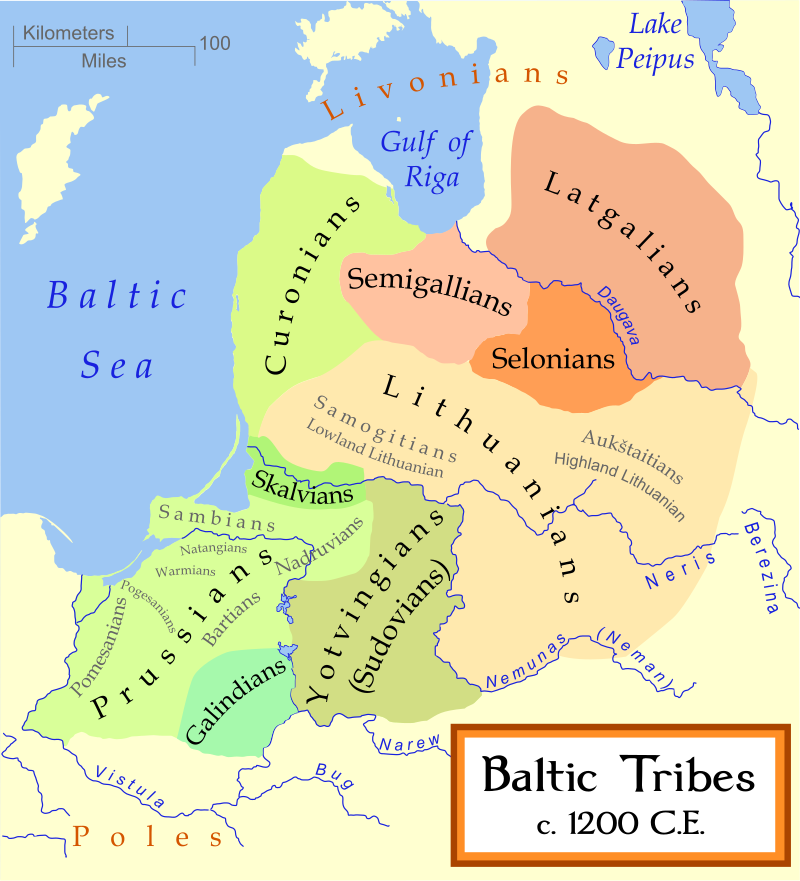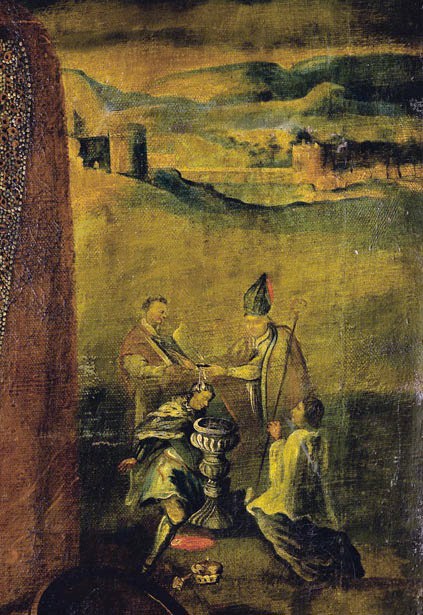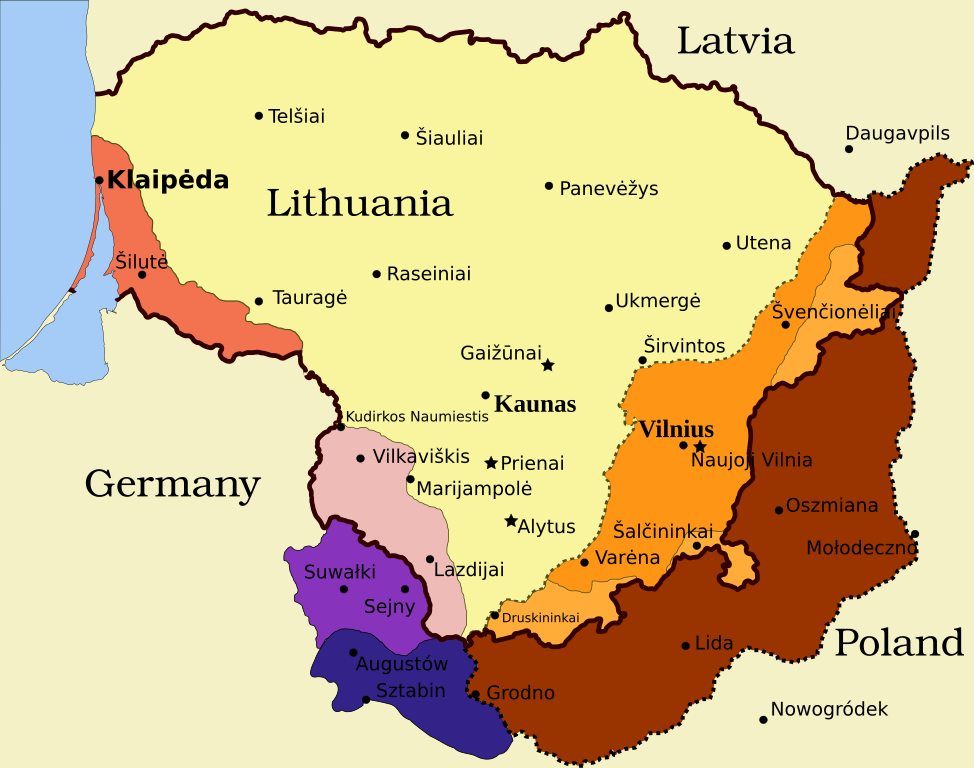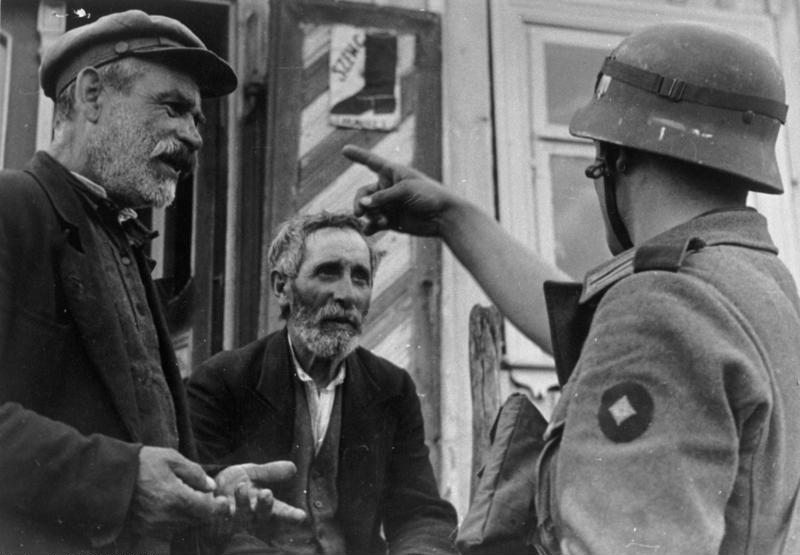 Lithuania (Lietuvos
in Lithuanian) is 3 million people country in the northeast part of
Europe. It belongs to the European Union (EU) and it's surrounded by
the Russian oblast of Kaliningrad, Latvia,
Poland and Belarus. The population has a mostly Catholic religious tradition;
the official language is Lithuanian (many people can still speak Russian and some,
English) and the official currency is the euro (€). Lithuania has 4
sites placed in UNESCO World Heritage list. The main city, and the capital city, of Lithuania is Vilnius, with other important cities like Kaunas or Klaipėda.
Lithuania (Lietuvos
in Lithuanian) is 3 million people country in the northeast part of
Europe. It belongs to the European Union (EU) and it's surrounded by
the Russian oblast of Kaliningrad, Latvia,
Poland and Belarus. The population has a mostly Catholic religious tradition;
the official language is Lithuanian (many people can still speak Russian and some,
English) and the official currency is the euro (€). Lithuania has 4
sites placed in UNESCO World Heritage list. The main city, and the capital city, of Lithuania is Vilnius, with other important cities like Kaunas or Klaipėda. What can I visit in Lithuania?
Here you have a list of places in Lithuania that are worth to be seen. Check them out and find out the ones you want to visit:- Aukštaitija National Park
- Curonian Spit National Park
- Druskininkai
- Dzūkija National Park
- Kaunas
- Klaipėda
- Nemunas Delta Regional Park
- Panevėžys
- Šiauliai
- Trakai Historical National Park
- Utena
- Vilnius
- Žemaitija National Park
History
 |
| Baltic tribes in 1200 |
 |
| Baptism of Mindaugas (17th century painting) |
 |
| Polish-Lithuanian Commonwealth in 1635 |
 |
| Map of Lithuanian territory during the interwar period |
 |
| Lithuanian Jews and a German Wehrmacht soldier in 1941 |
Untill 1926 coup d'etat Lithuania was a democracy and then Antanas Smetona became the authoritary President of Lithuania till 1940, period in which Lithuanian culture got a huge development. Before WW2 Lithuania received the 1939 German ultimatum to Lithuania and gave back Klaipėda Region to Germany and when it started, thanks to Molotov–Ribbentrop Pact, Lithuania was invaded for the Soviet Union till it was conquered by Germany during Barbarossa Operation and during Nazi Germany invation, more than 250,000 Lithuanian Jews were murdered as part of the Holocaust. In the end of WW2 Lithuania was conquered again by the Soviet Union, Vilnius region was given to the Lithuanian SSR and began a rapid sovietization of Lithuania. In this period 20,000 Lithuanian partisans participated in unsuccessful warfare against the Soviet regime in the 1940s and early 1950s, who were later killed or deported to gulags.
 |
| January Events in 1990 |
Lithuania isn't a big country, but it has its different ethnografic regions, each one which special features and characteristics (based on cultural differences of ordinary people living there and not on political history or administrative divisions). In the following map you can see them:
- Samogitia (Žemaitija)
- Highland (Aukštaitija)
- Dainava (Dzūkija)
- Sudovia (Suvalkija)
- unofficial capitals of each region
- Vilnius - capital of Lithuania
Unforgettable experiences
This places and experiences are a must if you want to discover and understand Lithuania. This is my top 10:| Vilnius |
- Vilnius: biggest Lithuanian city and capital of the country, Vilnius is the main attraction of the country and there are many things for sightseeing. It's historical importance and it's religious mixture give this city many things to explore. Getting lost in the city center it's simply marvelous and its contrast among architectural styles, amazing.
- Kaunas:
second biggest Lithuanian city and former Lithuanian capital city,
Kaunas can be considered the cultural capital of Lithuania. Not only due
to its delicious cultural experience but also for its history it's the
most "Lithuanian" city in Lithuania and it's city center is incredible.

Curonian Spit National Park - Curonian Spit National Park: definitively the most beautiful National Park in the country, this place of a weak beauty gives you an awesome natural landscape to enjoy, to practice outdoors sports, walk into the woods and relax in a beach. Visiting Nida is also getting deeper into the German heritage in this Lithuanian area.
- Šiauliai and the Hill of Crosses: this place near Šiauliai
can be considered one of the most interesting and bizarre in Lithuania,
but especially is a Lithuanian identity reaffirmation. No matter it was
destroyed by Soviet authorities, local population restored it shortly
and even bigger. It's a proof of the strong religious feeling of
Lithuanians.

Hill of Crosses - Klaipėda: third largest Lithuanian city and the main Lithuanian port, formerly known in German as Memel, this city still has many of its German period buildings, seeming a Central European city. Walking by its streets is a mixture of past heritage and future life.
- Druskininkai and Grūtas Park:
the most important spa town in Lithuania has an interesting past and
it's worth a visit. Trying on of its health resorts or walk by Nemunas
River are wonderful activities. Moreover near
it can be found Grūtas Park, an ironic, grotesque and thought-provoking
park with statues built during the Soviet Union period.
Trakai Historical National Park - Trakai Historical National Park: this little village is a perfect place to spend a day, thanks to its historic wealth as the first capital of the Kingdom of Lithuania and it's incredible castle in the lake. But it's a very important for the Karaites, a Jewish Tartar minory in the country with its own culture which is tending to disappear.
- Aukštaitija National Park: oldest
National
Park in the country, this area is a great place to explore Lithuanian
nature. Lakes, many lakes, and forests where getting lost and small
villages where knowing more about Lithuanian rural life, traditions and
jobs. It's also a door to the Soviet past in the town of Visaginas.

Žemaitija National Park - Žemaitija National Park: one of the most surprising places in the country, this National Park has different cultural characteristics, especially because of Samogitian language (or dialect). But the nature is great, perfect to unwind and practice cycling or hiking while discovering its heritage, like the nice Cold War Museum.
- Dzūkija National Park: the biggest National Park in Lithuania is a great experience too. It's perfect for water sports, berries and mushrooms lovers but also for people interested in traditions like black ceramics and well-preserved villages.
Planning your holidays
These are some possible journeys you may do in Lithuania so visit parts of it or discover it all. Lithuania main sightseeing points can't be visited in less than 5 days and a smart fast journey could last 7 days. If you want to get deeper into Lithuania and do things with more tranquility, 10 days can be enough for it.a) 5 days tour
This short journey in Lithuania should start and finish in Vilnius. Here you could stay 1 day and part of another, enjoying its history and architecture. In remaining of the 2nd day you can go to Trakai Historical National Park and visit it (and even Kernavė in case of having time), going back to Vilnius to sleep. The following day, early in the morning, the visitor could go to Kaunas and arrive there soon, being able to enjoy the city the rest of the day and knowing the cultural capital of the country. The 4th day could consist in going to Klaipėda, exploring the center of the city and before lunch time, get into Curonian Spit National Park to enjoy the afternoon, evening and a beautiful sunset before returning to Klaipėda to sleep. The 5th and last day would consist in returning to Vilnius via Šiauliai, to know the 4th largest city in the country and the famous Hill of Crosses.
b) 7 days tour
The possibility of adding 2 more days would increase the places to visit but the tour should still start and finish in Vilnius.
Here you could stay 1 day and part of another, enjoying its history and
architecture, specially its UNESCO World Heritage Old Town. In remaining of the 2nd day you can go to Trakai Historical National Park and visit it (and even Kernavė in case of having time), going back to Vilnius to sleep. The 3rd day can consist in going south to Druskininkai, enjoy this spa town and Grūtas Park in the morning and get into Dzūkija National Park in the afternoon (or vice versa). The following day, early in the morning, the visitor could go to Kaunas
and arrive there soon, being able to enjoy the city the rest of the day
and knowing the cultural capital of the country. The 5th day could
consist in going to Klaipėda, exploring the center of the city and before lunch time, get into Curonian Spit National Park to enjoy the afternoon, evening and a beautiful sunset before returning to Klaipėda to sleep. The 6th day would consist in returning to Vilnius via Šiauliai, to know the 4th largest city in the country and the famous Hill of Crosses. For the 7th day it can get be a good idea getting deeper into Lithuanian rural life and nature at the largest national park in the country, Aukštaitija National Park.
c) 10 days tour
Once chosen this possibility the visitor will be able to enjoy Lithuania with much more calm and get deeper into their culture. The tour should still start and finish in Vilnius, where staying 1 day and part of another, enjoying its history and architecture, specially its UNESCO World Heritage Old Town. In remaining of the 2nd day you can go to Trakai Historical National Park and visit it (and even Kernavė in case of having time), going back to Vilnius to sleep. The 3rd day can consist in going south to Druskininkai, enjoy this spa town and Grūtas Park in the morning and get into Dzūkija National Park in the afternoon (or vice versa). The following day, early in the morning, the visitor could go to Kaunas and arrive there soon, being able to enjoy the city the rest of the day and knowing the cultural capital of the country. The 5th day could consist in going to Klaipėda, exploring the center of the city and in the afternoon either going to the beach resort of Palanga or exploring the unspoilt Nemunas Delta Regional Park. The next day would completely consist in get into Curonian Spit National Park to enjoy the dunes, beaches and forests before returning to Klaipėda to sleep. On the 7th day the visitor can get deeper into one of the ethnographic regions of Lithuania with more personality by visiting Žemaitija National Park and its surrounding area. The 8th day would consist in going to Šiauliai, to know the 4th largest city in the country and the famous Hill of Crosses. Following to that day the visitor can spend the day visiting the cities, towns and villages of the north of Lithuania, mainly focusing in places like Panevėžys, Biržai, Anykščiai, Labanaras Regional Park or Utena. For the 10th and last day it can get be a good idea getting deeper into Lithuanian rural life and nature at the largest national park in the country, Aukštaitija National Park.How can I arrive and move within Lithuania?
Lithuania is well communicated with neightbouring countries such as Latvia and
Poland, mainly via Vilnius. Vilnius, Kaunas and Šiauliai
are connected with most of the important destinations in the Baltic countries and in the rest of Europe. The best mean of transport to move in
the country are trains to move to large cities and the bus to smaller destinations (or other destinations at unusual times).
- Plane: there are international flights to Vilnius International Airport (the most important one in Lithuania) from many European cities and also to the airport in Palanga. There are fewer flights to the airport of Kaunas. Most of the flights are from low cost companies.
- Boat: there are passenger/car ferries to Klaipėda from countries like Sweden, Denmark and Germany (slow and expensive).
- Train: Lithuania's railway system is good and choosing either train or bus depends on the route to do or the time when it wants to be done. The negative aspect is that the railway system isn't currently connected to neighbouring Latvia (although it's said that it will change with Rail Baltica). The railway system connects Vilnius with places like Kaunas, Šiauliai, Panevėžys or Klaipėda. There are also trains to international destinations like to Białystok, Warsaw, Minsk, Kaliningrad or Moscow.
- Bus: this is the cheapest way to move in Lithuania (also the best way to arrive to smaller destinations) and the best idea to go to another Baltic country. There are frequent buses from Vilnius to all the main cities and towns of the country and there are also connections among them (although less frequent). There are buses that connect Vilnius, Kaunas and Šiauliai with places such as Riga, Warsaw or Tallinn. The offer of bus trips in Vilnius is larger, including destinations like Poznań, Berlin, Minsk, Kyiv, Prague, St. Petersburg or Moscow.
- Car: this is almost always the most comfortable way of moving for the lack of timetables to follow. It's required to have a green card (International Insurance Card). Most of the roads in Lithuania are in fairly good conditions and driving in the country is easy.
 |
| Train map of Lithuania |
What can I eat and drink in Lithuania?
 |
| Cepelinai |
 |
| Šakotis |
 |
| Midus |
Talking about drinking, the most famous Lithuanian drink is the beer (alus) throughout all the country, usually drank with piršteliai prie alaus (puff pastries served with beer), yet not the oldest one, having midus (mead) that honour. As in many other northern countries, there are many other kind of stronger spirits like trauktinė (strong herbal vodka), degtinė (rye, wheat or potato vodka) or krupnikas (honey liqueur). There are other non alcoholic drinks like gira (similar to kvass), arbata (tea) or kava (coffee).
Learn some Lithuanian
Lithuanian is the oficial language of Lithuania and is currently spoken by 3.1 million people aprox. Lithuanian language is related to Latvian, but visitors who speak Russian won't have problems of communication because it's still widely known. Compared with Latvian in Latvia, Lithuanian is a much more known and used language in Lithuania. In Samogitia it's also spoken Samogitian, a dialect of Lithuanian/language with a huge Lithuanian influence that is spoken by less than 500,000 people. In the Curonian Spit, Kursenieki (language related to Latvian) used to be spoken but nowadays its nearly extinct with 4 speakers aprox.
These are some basic words in Lithuanian:
These are some basic words in Lithuanian:
Lithuanian
|
English
|
Lithuanian
|
English
|
Sveiki
|
Hello
|
Prašau
|
Please
|
Labas
|
Hi
|
Dėkoju
|
Thanks
|
Kaip gyvuojate?
|
How are you?
|
Taip
|
Yes
|
Sudie!
|
Goodbye!
|
Ne
|
No
|
Labanakt!
|
Good night
|
Aš nekalbu lietuviškai
|
I don’t speak Lithuanian
|
Useful links
In case you want to look for more information about Lithuania (https://lithuania.travel/en/) or its cities, towns and places, here there's a list with some pages to get it:- Aukštaitija National Park (https://www.aparkai.lt/en/).
- Curonian Spit National Park (http://www.nerija.lt/en).
- Druskininkai (http://info.druskininkai.lt/new/en/).
- Dzūkija National Park (http://www.cepkeliai-dzukija.lt/22553/tekstas.html).
- Kaunas (https://visit.kaunas.lt/en/).
- Klaipėda (https://www.klaipedainfo.lt/en/).
- Nemunas Delta Regional Park (http://www.nemunodelta.lt/20949/home.html).
- Panevėžys (https://www.panevezysinfo.lt/en/).
- Šiauliai (http://tic.siauliai.lt/?lang=en).
- Trakai Historical National Park (http://www.seniejitrakai.lt/news/).
- Utena (https://www.utenainfo.lt/en/).
- Vilnius (http://www.vilnius-tourism.lt/en/).
- Žemaitija National Park (http://zemaitijosnp.lt/en/).



